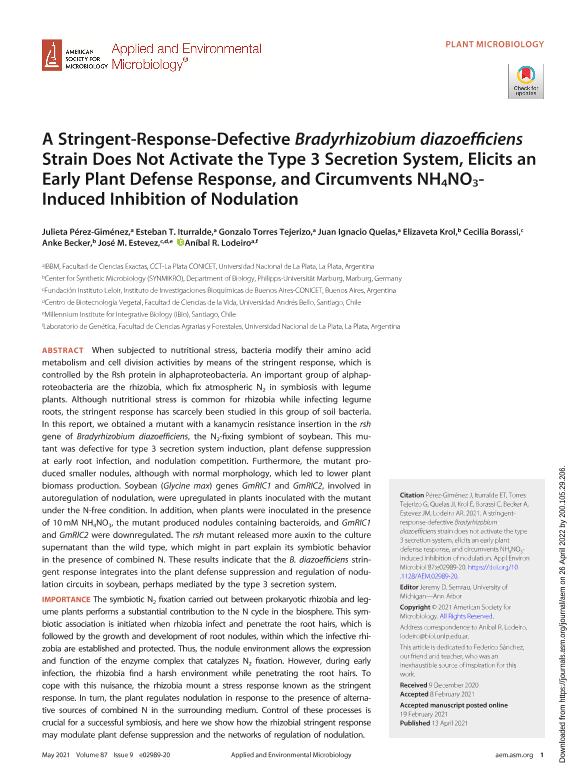Artículo
A stringent response-defective Bradyrhizobium diazoefficiens does not activate the type-3-secretion system, elicits early plant defense, and circumvents NH 4 NO 3 -induced inhibition of nodulation
Pérez Giménez, Julieta ; Iturralde, Esteban Tomás
; Iturralde, Esteban Tomás ; Torres Tejerizo, Gonzalo Arturo
; Torres Tejerizo, Gonzalo Arturo ; Quelas, Juan Ignacio
; Quelas, Juan Ignacio ; Krol, Elizaveta; Borassi, Cecilia
; Krol, Elizaveta; Borassi, Cecilia ; Becker, Anke; Estevez, Jose Manuel
; Becker, Anke; Estevez, Jose Manuel ; Lodeiro, Anibal
; Lodeiro, Anibal
 ; Iturralde, Esteban Tomás
; Iturralde, Esteban Tomás ; Torres Tejerizo, Gonzalo Arturo
; Torres Tejerizo, Gonzalo Arturo ; Quelas, Juan Ignacio
; Quelas, Juan Ignacio ; Krol, Elizaveta; Borassi, Cecilia
; Krol, Elizaveta; Borassi, Cecilia ; Becker, Anke; Estevez, Jose Manuel
; Becker, Anke; Estevez, Jose Manuel ; Lodeiro, Anibal
; Lodeiro, Anibal
Fecha de publicación:
13/04/2021
Editorial:
American Society for Microbiology
Revista:
Applied and Environmental Microbiology
ISSN:
0099-2240
Idioma:
Inglés
Tipo de recurso:
Artículo publicado
Clasificación temática:
Resumen
When subjected to nutritional stress, bacteria modify their amino acid metabolism and cell division activities by means of the stringent response, which is controlled by the Rsh protein in alphaproteobacteria. An important group of alphaproteobacteria are the rhizobia, which fix atmospheric N2 in symbiosis with legume plants. Although nutritional stress is common for rhizobia while infecting legume roots, the stringent response was scarcely studied in this group of soil bacteria. In this report, we obtained a mutant in the rsh gene of Bradyrhizobium diazoefficiens, the N2-fixing symbiont of soybean. This mutant was defective for type-3-secretion system induction, plant-defense suppression at early root infection, and competition for nodulation. Furthermore, the mutant produced smaller nodules, although with normal morphology, which lead to lower plant biomass production. Soybean genes GmRIC1 and GmRIC2, involved in autoregulation of nodulation, were upregulated in plants inoculated with the mutant in N-free condition. In addition, when plants were inoculated in the presence of 10 mM NH4NO3, the mutant produced nodules containing bacteroids, and GmRIC1 and GmRIC2 were downregulated. The rsh mutant released more auxin to the culture supernatant than the wild type, which might in part explain its symbiotic behavior in the presence of combined-N. These results indicate that B. diazoefficiens stringent response integrates into the plant defense suppression and regulation of nodulation circuits in soybean, perhaps mediated by the type-3-secretion system.IMPORTANCE The symbiotic N2 fixation carried out between prokaryotic rhizobia and legume plants performs a substantial contribution to the N-cycle in the biosphere. This symbiotic association is initiated when rhizobia infect and penetrate the root hairs, which is followed by the growth and development of root nodules within which the infective rhizobia are established and protected. Thus, the nodule environment allows the expression and function of the enzyme complex that catalyzes N2 fixation. However, during early infection the rhizobia find a harsh environment while penetrating the root hairs. To cope with this nuisance, the rhizobia mount a stress response known as stringent response. In turn, the plant regulates nodulation in response to the presence of alternative sources of combined-N in the surrounding medium. Control of these processes is crucial for a successful symbiosis, and here we show how the rhizobial stringent response may modulate plant defense suppression and the networks of regulation of nodulation.
Palabras clave:
BRADYRHIZOBIUM DIAZOEFFICIENS
,
STRINGENT RESPONSE
,
PLANT DEFENSE
,
SYMBIOSIS
Archivos asociados
Licencia
Identificadores
Colecciones
Articulos(IBBM)
Articulos de INST.DE BIOTECNOLOGIA Y BIOLOGIA MOLECULAR
Articulos de INST.DE BIOTECNOLOGIA Y BIOLOGIA MOLECULAR
Articulos(IIBBA)
Articulos de INST.DE INVEST.BIOQUIMICAS DE BS.AS(I)
Articulos de INST.DE INVEST.BIOQUIMICAS DE BS.AS(I)
Citación
Pérez Giménez, Julieta; Iturralde, Esteban Tomás; Torres Tejerizo, Gonzalo Arturo; Quelas, Juan Ignacio; Krol, Elizaveta; et al.; A stringent response-defective Bradyrhizobium diazoefficiens does not activate the type-3-secretion system, elicits early plant defense, and circumvents NH 4 NO 3 -induced inhibition of nodulation; American Society for Microbiology; Applied and Environmental Microbiology; 87; 9; 13-4-2021; 1-14
Compartir
Altmétricas



